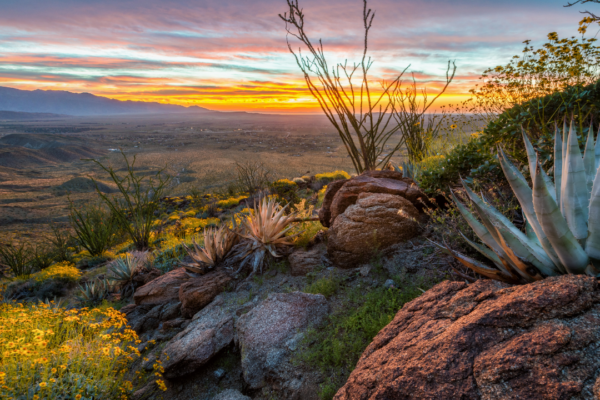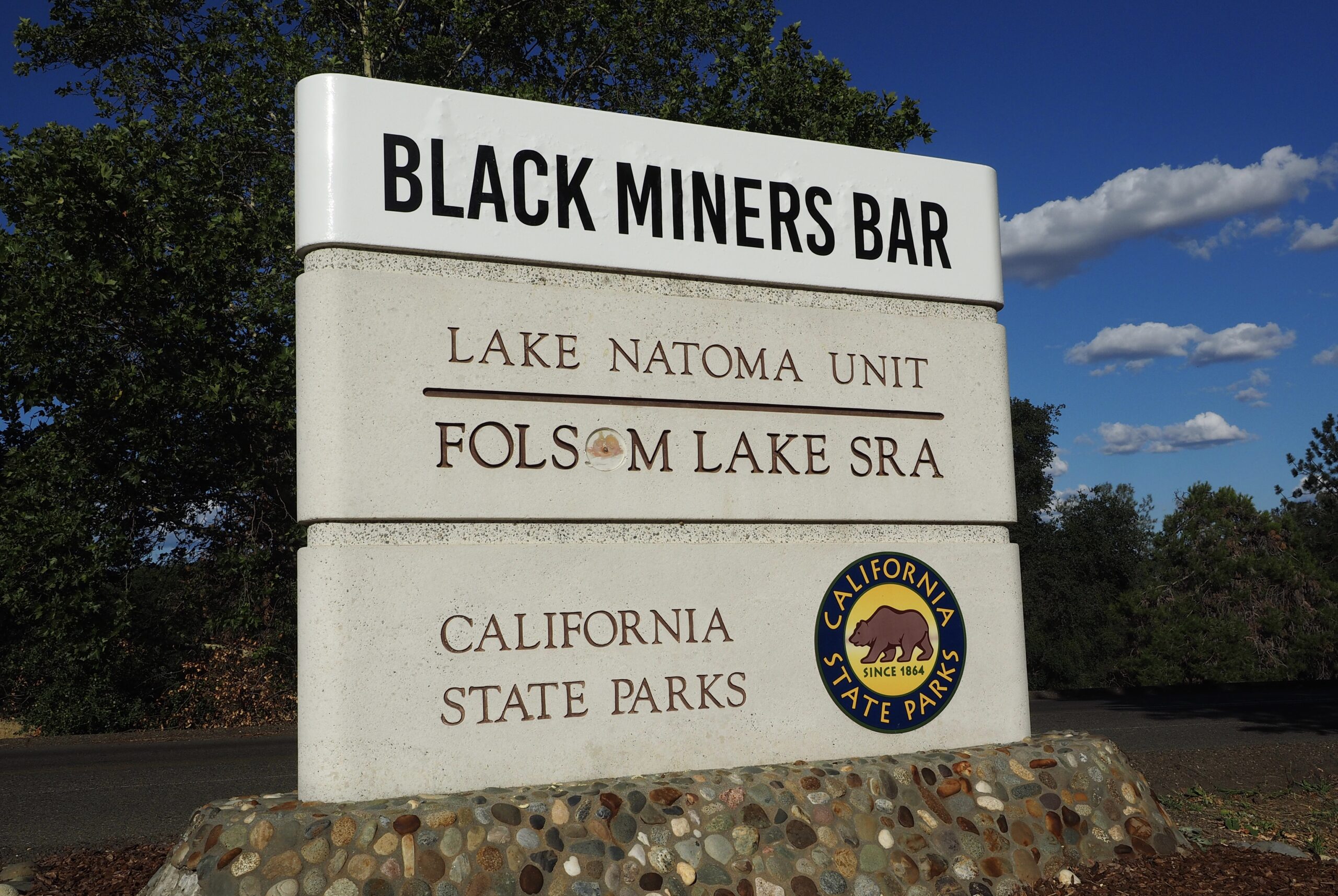Rebuilding the “Three Senses Trail” at Calaveras Big Trees State Park
By Rod Smith
The last five and a half years has been a learning experience for me that I would like to share with others. With the help of dedicated park staff, and the broader community we have rebuilt the Three Senses Trail at Calaveras big Trees State Park (CBTSP). Just as important, I am learning what is involved with creating a meaningful experience for our non-sighted visitors.
The trail at CBTSP known as “The Three Senses Trail” was the first project taken on by the newly formed Calaveras Big Trees Association (CBTA) in 1974. The trail was commissioned in 1976, fourteen years before the Americans with Disabilities Act (ADA) was passed. Ernestine Russell, a board member of CBTA proposed the idea and planned the project. Ms. Russell worked with the blind in Sacramento.
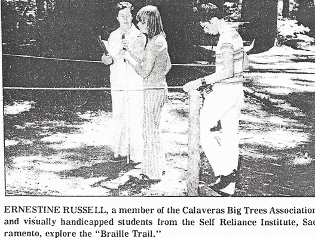
I became aware that the trail needed renovation while working with the park’s volunteer trail maintenance crew. At the time I was also the President of the Arnold Lions Club and a member of the CBTA board. I was also aware that the trail was an important part of the Education and Interpretation portion of the Park Master Plan.
The Three Senses Trail was eight hundred feet in length with fourteen stations. The text at each station described a feature of the forest at the station. The text was in braille and large print. Originally white, they had turned black with forty years of weathering. The descriptions were no longer relevant. Only one of the original five benches remained.
In December 2015, I approached Regional Superintendent Greg Martin and proposed to take on the project. Greg supported the idea. I approached the District Lions, the CBTA and the Calaveras Community Foundation in February 2016 and received the support of all three organizations. Over the next two years the Arnold Lions Club raised two hundred thousand dollars. The principal contributor was the Lions Clubs International Foundation. That foundation pledged a matching grant of one hundred thousand dollars.
The renovation project is essentially complete. There are now ten stations created to introduce the visitor to the community of the Giant Sequoia Forest. The stations are less prone to becoming irrelevant over time. As on the previous trail, the stations have large print and braille (but modern braille).
The stations have tactile features including castings of birds (Robins sculpted by Yon Chambers, shown below) at the station about birds. We also developed an app specific for this trail. Beacons are located at each station and the app will pick up that beacon and begin to describe the features of the station.
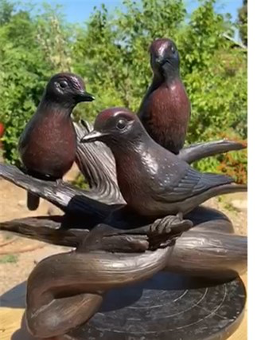
Another new feature of the project is a “Sensory Garden.” Plants were collected by the Sensory Garden volunteers from different environments within the park and planted in the garden. Visitors will be able to touch and smell these plants. This portion of the project is led by Claudia Beymer, a CBTSP docent and a California Master Gardener. The Sensory Garden is a high maintenance feature that requires specialized knowledge.
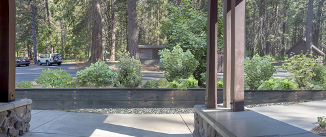
Sensory Garden, Artist’s Conception by Alan Beymer
The project could not have happened without the enthusiastic support of the park staff. The initial design and estimating were done with the assistance of the park staff. The park staff reached out to the department headquarters in Sacramento for technical support, then the district staff reviewed the design informally. When we hit the need for formal documentation, that went surprisingly smoothly because of this early support.
The project was a great morale booster for the park volunteers and staff. I believe that the relationship between the park administration and CBTA changed because of the project.
This was an important project for the District Lions as well. The Lions recognized the project as a Legacy Project for the Lions Centennial and received the International Presidents medal, one of two hundred internationally. A past International President of the Lions Clubs International is planning to visit the trail in the summer of 2022.
The foundations that we approached for funding and the department all ask the question “how will the project be maintained after it is completed?” The wording of that question should have read “how will the project be sustained?”
Sustaining the trail becomes much more complex when you incorporate technology. You need a plan that addresses:
• How do we bring non-sighted visitors to the park?
• Are there other visitors that can benefit from the trail experience?
• How do we train docent guides for non-sighted visitors?
• How do we manage the app and the electronic devices?
At CBTA we are fortunate to still have a connection to the District Lions. We will encourage Lions Clubs within the district to sponsor groups to visit the park. The Stockton San Joaquin Lions Club sponsored a visit of the Sisters of the White Cane, a club of non-sighted women from Stockton, (shown below).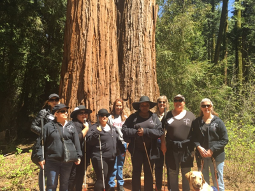
Sisters of the White Cane, a club of non-sighted women from Stockton, California.
The Environmental Travelling Companions, an organization that has been helping the blind and disabled to enjoy outdoor experiences for fifty years, has their winter program based in Arnold. A visit to Big Trees State Park is always included in their winter program. Nevertheless, “marketing” must be part of the sustainability plan for CBTSP.
The tag line for the funding brochure was “we experience our world through our senses.” Yes, we do experience our world through our senses. A non-sighted person’s experience will be different than a sighted person, but that need not be limiting to the experience of the non-sighted. Because a sighted person does not know the life experience of a non-sighted person, there is a need for docent training.
What are the lessons to be learned from the “Renovation of the Three Senses Trail Project”? The most important lesson is that where there are cultural differences in populations, we must honor and respect both cultures. We are beginning to understand the principle of reaching out to other cultures–including people with disabilities–but theory and practice are vastly different. In their thank you note, the Sisters of the White Cane specifically noted that “they felt safe.” Sighted people do not always recognize that need.
Not surprisingly, we are finding elderly visitors who are unable to experience the park. now can enjoy the community of the Giant Sequoia Forest on this trail. Similarly, parents can instruct their children who are unable or unwilling to walk the mile and one-half long North Grove trail.
Finally, another important lesson is that there is a need to develop a “Sustainability Plan.” This is now underway at CBTA.
My experience with the Three Senses Trail also showed me that it takes perseverance to create something like the Three Senses Trail even in the parks system that purports to encourage inclusiveness and diversity. It takes effort and perseverance to maintain it and benefit from it. Clever ideas are only promising ideas until someone puts the time and energy into implementing them and sustaining them.

